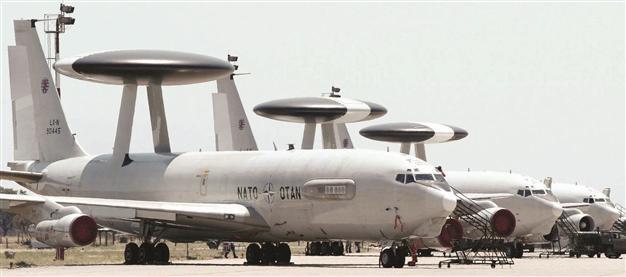Boeing launches spy plane training for Turkish staff
ANKARA - Hürriyet Daily News

Three E-3 A airplanes of the Nato Airborne Early Warning and Control Forces are seen at the airport of Beja, central Portugal, in this file photo. AP photo
Boeing, the American aerospace company, launched a training program for Turkey’s airborne early warning and control (AEW&C) project, focused on teaching the specific mechanics of planes the company has been building for Turkey at Boeing facilities near Seattle.The training will cover “the mechanical avionics, mission systems and electronic warfare subsystems of the 737 AEW&C aircraft,” a statement issued by the company said.
Boeing, the largest manufacturer of commercial jetliners, will deliver the first of four spy planes for the Turkish Air Force’s long-delayed and multibillion-dollar airborne early warning and control program this year, a senior company official said also said.
“We’re looking forward to the first delivery this year,” said Mark Ellis, director at Boeing for Turkey’s AEW&C Peace Eagle program. The remaining three planes are expected in 2013.
In 2003, Turkey’s Undersecretariat for Defense Industries ordered four 737-700 AEW&C aircraft from Boeing, along with a ground radar, control systems and ground control segments for mission crew training, mission support and maintenance support.
The deal closed for approximately $1.6 billion and the original contract contained an option for two additional aircrafts. But both Turkish and Boeing officials have said there was no indication that Ankara would buy the two additional aircraft.
In 2007, software production and integration problems delayed the delivery of the first plane from Boeing, according to United States and Turkish officials. At the time, Boeing officials said the development had been tougher that expected.
Turkey’s contract came one year after Australia signed a similar deal for six 737-700 AEW&C aircrafts and related systems. Australia’s program also faced similar delays, but eventually Boeing delivered four aircraft and has begun training Royal Australian Air Force maintainers. Progress with the Australian program paved the way to remove many of the problems causing delay in the Turkish program.
Turkey plans to use the AEW&C planes for national defense and also for NATO-related missions.
The program, which is based on Boeing’s popular 737-700 civilian aircraft, will come with Northrop Grumman’s MESA electronically scanned array radar, an all-weather, 360-degree air and maritime mode system.
An airborne early warning and control system is a radar system carried by an aircraft and designed to detect other planes. Used at a high altitude, the radar allows the operator to distinguish between friendly and hostile aircraft from hundreds of miles away. AEW&C aircraft are used offensively to direct fighters to their target locations, and defensively to counter attacks.
















